Quickly Draw Body for Comics
Beingness the fourth installment of my How to Describe Comics serial.
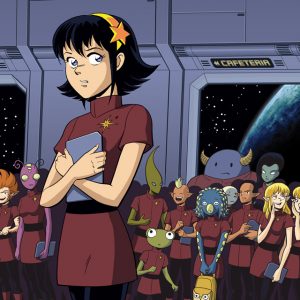 Now that you lot know who your character is, it's time to draw her. Seeing how you're going to be cartoon this grapheme a lot over the course of your comic, information technology's a good nail down their look so you can be consequent. However, it's not uncommon for a character design to evolve over fourth dimension in a comic—it certainly did to the characters in Paradigm Shift—simply spending the fourth dimension to piece of work out the character'due south overall shape, costume and before starting Folio 01 is worth the effort. Additionally, working on understanding human being beefcake and figure cartoon practice can really take your character drawing to a new level.
Now that you lot know who your character is, it's time to draw her. Seeing how you're going to be cartoon this grapheme a lot over the course of your comic, information technology's a good nail down their look so you can be consequent. However, it's not uncommon for a character design to evolve over fourth dimension in a comic—it certainly did to the characters in Paradigm Shift—simply spending the fourth dimension to piece of work out the character'due south overall shape, costume and before starting Folio 01 is worth the effort. Additionally, working on understanding human being beefcake and figure cartoon practice can really take your character drawing to a new level.
Getting Into Graphic symbol
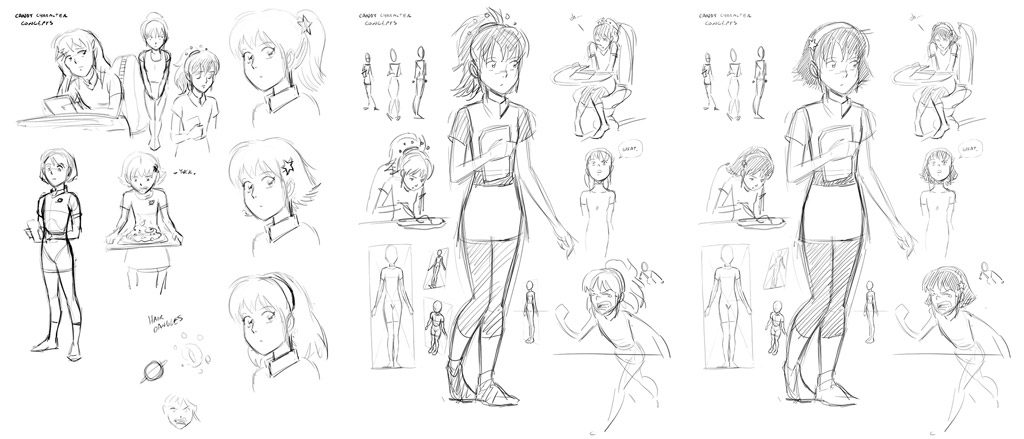
Here's some examples of playing around with a character before starting a projection. This is Processed from STRANGER. I knew I wanted her to look a bit like a Miyazaki character, but I played around with a couple of designs before settling on her concluding expect:
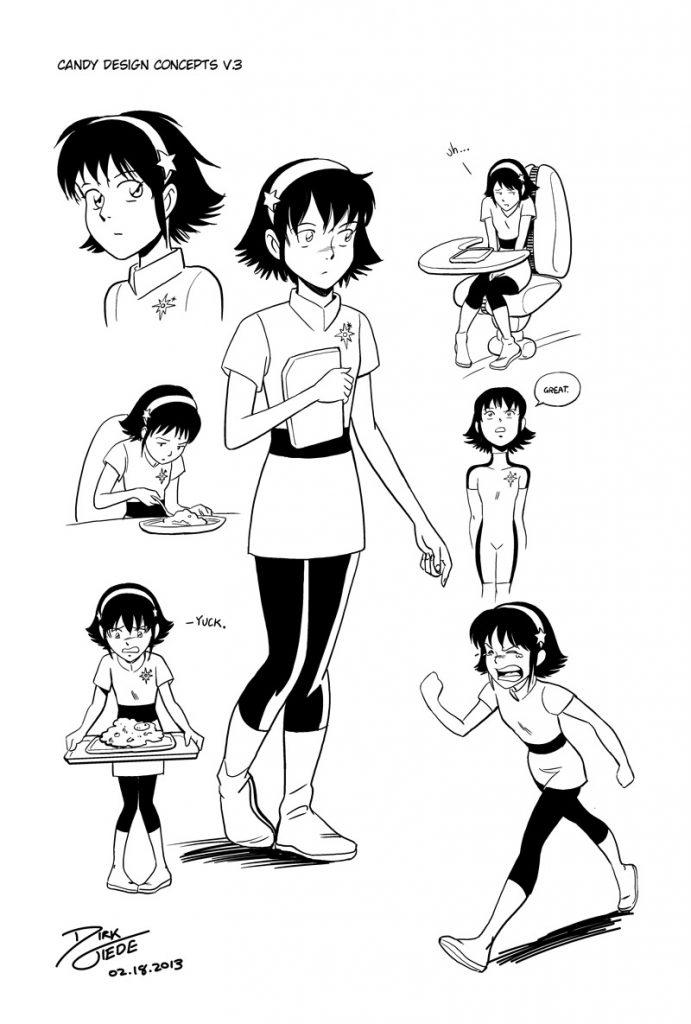
For Candy's counterpart, Nikka, it took a fiddling more work before I nailed downwards her pattern. Again, I took some inspiration from Miyazaki past riffing off of Sen from "Spirited Away". Notwithstanding, by borrowing the rounder caput and broad-spaced optics and combining them with features inspired by a cuttlefish, I was able to create something entirely new.
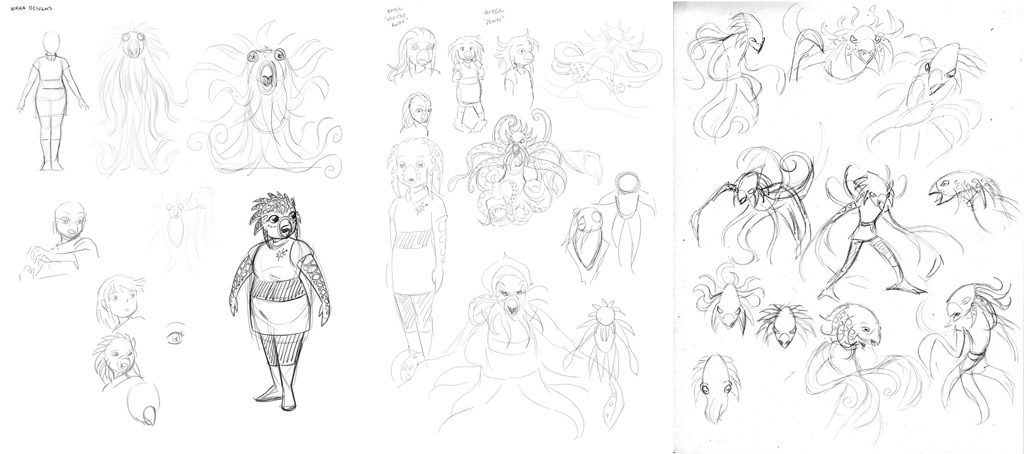
Here'southward her final design:
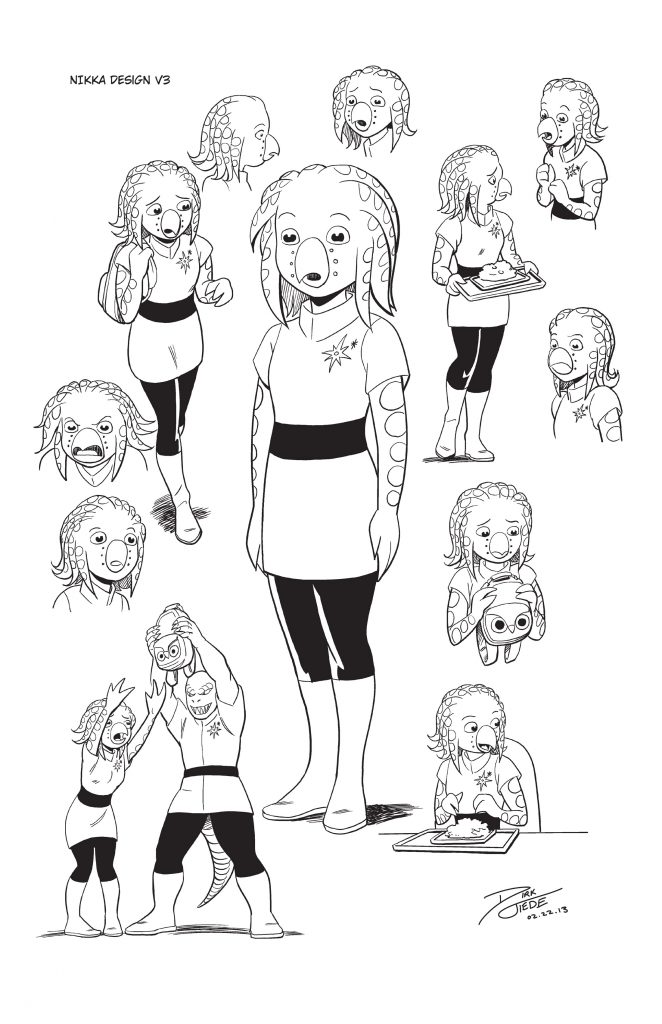
A Quick Annotation on Silhouette

The first matter anyone will run into about your character is the shape his or her outline creates, not the details within. Having characters with distinct body and head shapes will assistance make them more recognizable in your story.
The Head & Confront
Firstly, permit'due south look at the head and face considering the are probably the most important features for identifying your graphic symbol and letting him express himself. Fifty-fifty the shape of the head tin can suggest a personality—triangular, round, foursquare. Each gives a unlike feel. Also, adding differently shaped pilus or other features that can create a unique, recognizable shape can assist tremendously besides. This is how I designed the alien characters for the story STRANGER:

In society to draw my characters' heads from whatever angle, I use two basic caput shapes as a starting point and then squash and stretch them into the guess shape. I borrow from techniques used in blitheness to construct a character from more basic shapes underlying the caput. The first is the classic anime "seed" shaped head:

I describe the seed by starting with a circle (or spherical brawl, as I imagine it in my mind) and and then hanging a pointed jawline off that circumvolve a various angles. And so by drawing a "cross" dividing the eye of the confront and where the eyes will be, you tin use this seed shape to draw that head from any angle. This is the shape I use for Kate's head in Image Shift. Using this as my starting betoken, I crude the entire head, then add in more particular before completing the final drawing. I use this process for all my comics and analogy, working from rough forms through final epitome. This is how I use the seed shape to depict Kate from the front, side and iii/iv view:
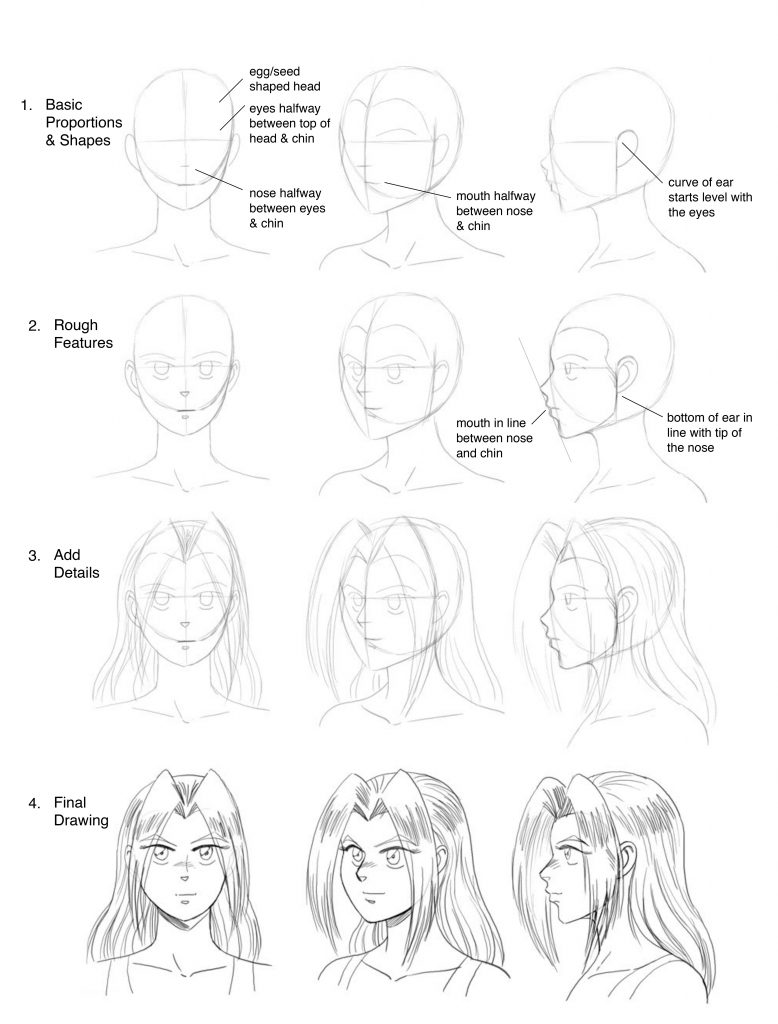
Accept note of how the proportions of the face translate across between the differing angles. The line that runs through the eyes is roughly halfway betwixt the superlative of the head and the chin. The tip of the nose sits about halfway between the heart line and the chin. The rima oris sits nigh halfway between the olfactory organ and the chin. From the side, if you draw a line from the tip of the nose to the mentum, the lips volition roughy autumn in line inside in that location. The ears sit on a line that is halfway between the front of the head and the back and their curve starts in line with eyes. If you imagine the centre line of the face curving to the left or right and the eye line curving up or down, you can start to see the head turn in your heed'due south heart and employ this to draw the caput and face from any angle like so:
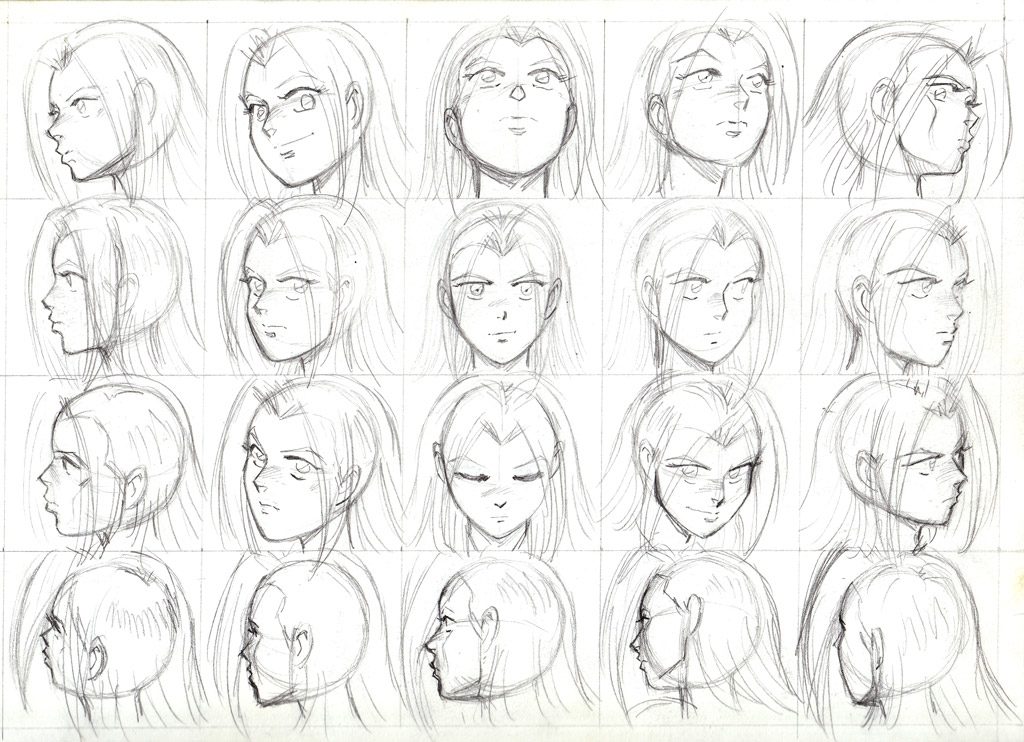
The second basic head shape I utilise is based more closely on a more than classical human caput shape used in American superhero comics:

This is the shape I use for Mike's head in Prototype Shift. I offset the head with more than of an egg shape. And then, I determine which direction the head is facing by drawing a "cross", merely like in the seed instance above. I hang the jaw down from the egg shape Unlike the anime "seed", the jaw line changes more radically between a straight on view and the profile. It's more than a wedge shape and will take more do to describe from every bending. Y'all can imagine it being a chip like a cube, just tapering down to create the mentum. Also the cranium isn't completely round like a sphere or egg, only rather is flattened somewhat on the sides. I denote this with lines along the sides of the brow that wrap around the top of the caput
Here's how I use this to describe Mike from the front, side and 3/4 view:

Like in the seed case, there are certain proportions to pay attention to, though they differ somewhat. In this mode of head, the eyes lay about halfway down the egg shape. Then the jaw extends downwardly a distance equal to about half the egg shape—thus dividing the face into thirds: top of the head to optics, optics to bottom of egg shape, lesser of egg shape to chin. The optics are smaller on the face than in the previous instance and there should be roughly one eye distance between them.
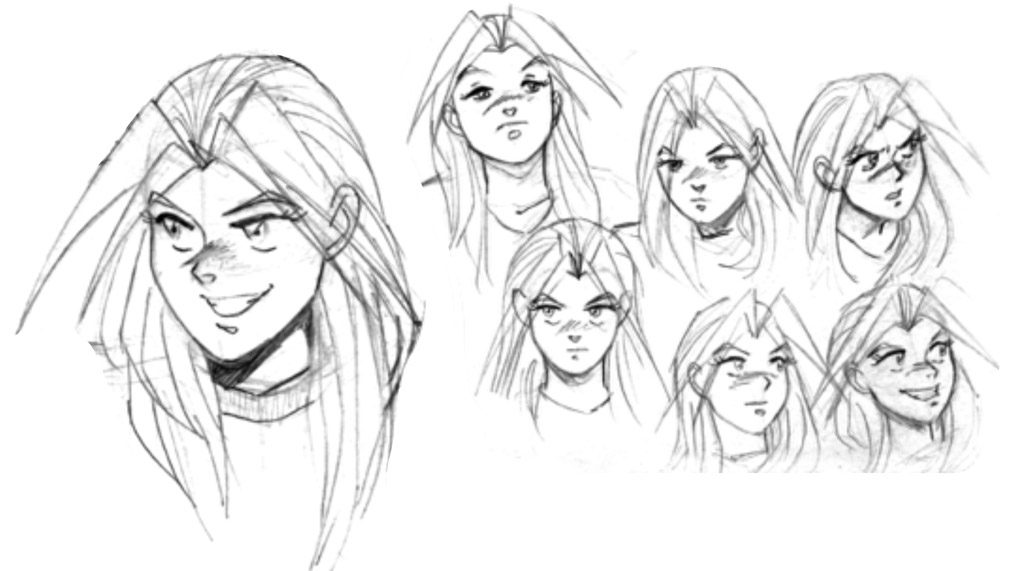
To work on details like pilus and drawing heads from many unlike angles I recommend practicing drawing from life, copying photos and doing the occasional master study of an artist who y'all greatly adore. The more you practice, the more you lot volition expand your visual vocabulary as an creative person and yous can combine, mix and match and create brand new features that are purely your own. The same goes for expressions. Play effectually in your sketchbook and find the faces you feel express your character's emotions the most vividly.
Drawing the Figure
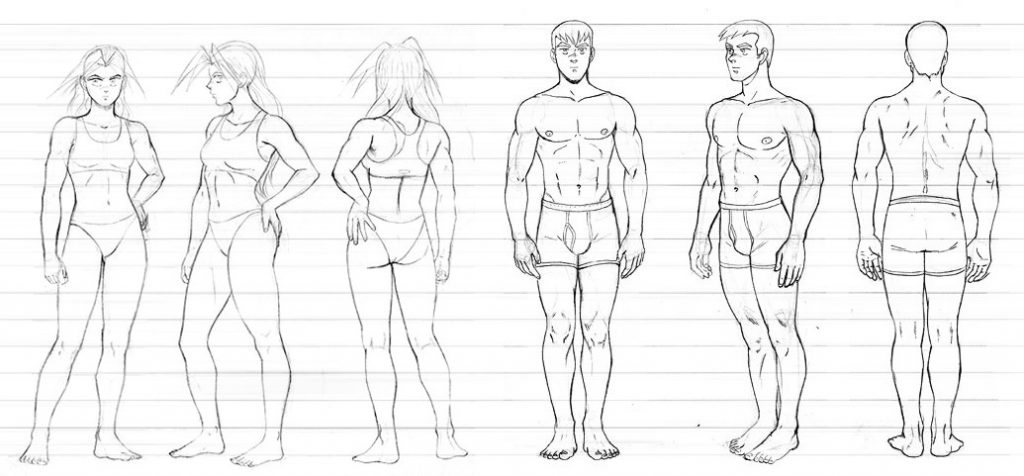
The first footstep in drawing full-trunk homo characters is to nail down basic proportions. Of course, cartoon characters tin can exist drawn with many different proportions, so I am going to focus on a relatively realistic man proportions first. This method tin can be modified to stretch characters to exist taller or shorter as needed afterward. Above we accept Kate and Mike as examples of "ideal" human female and male proportions. Oft in figure drawing, proportions are measured in "heads" because information technology is an easy way to check if the features are in the right place in a cartoon, peculiarly if the effigy is fatigued relatively directly on. Notice the lines going through the paradigm above—they measure the number of "heads" used for each character.
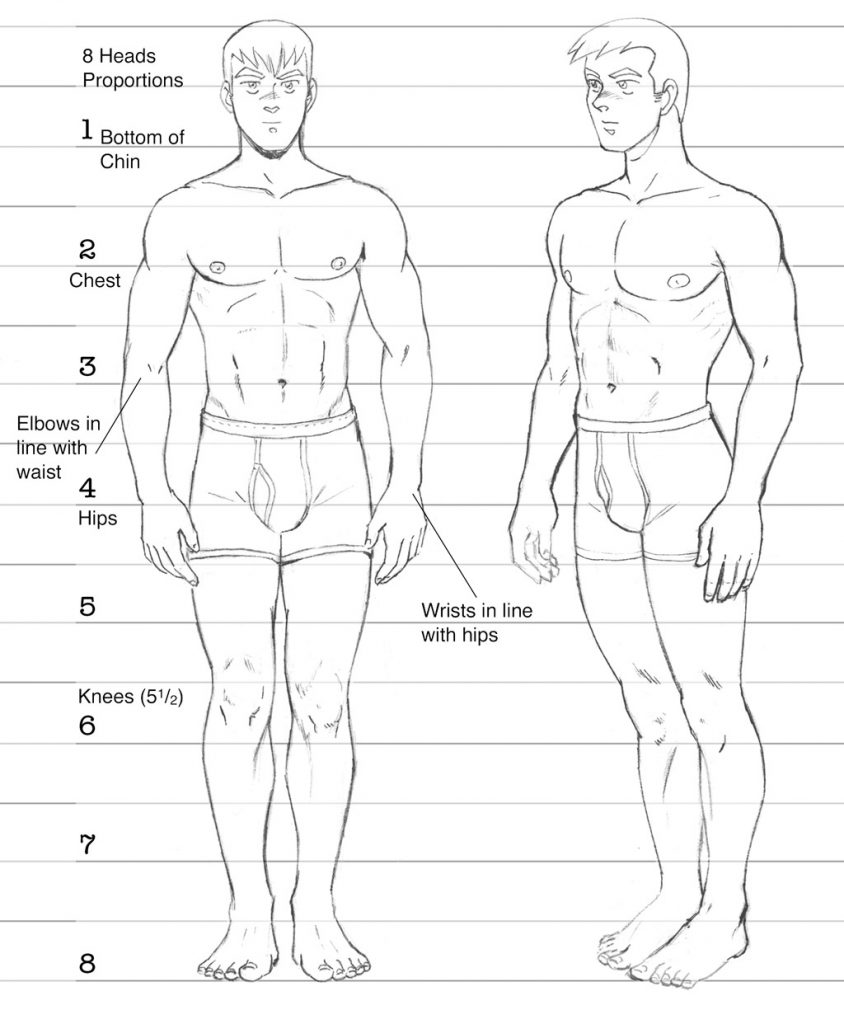
Mike uses archetype western "heroic" proportions, measuring 8 heads. They break down as follows:
-
- Caput
- Chin to chest
- Chest to navel
- Umbilicus to bottom of the hips (crotch)
- Bottom of hips to mid-thigh
- Mid-thigh to knees
- Knees to mid-shin
- Mid-shin to lesser of the anxiety.
Also note the proportions of the arm. The elbows are merely above waist superlative and sit roughly in line with the bottom of the rib cage. The wrist fall approximately in line with bottom of the hips. For men, the ribcage and hips are roughly the same width and the shoulders are wider than the hips.
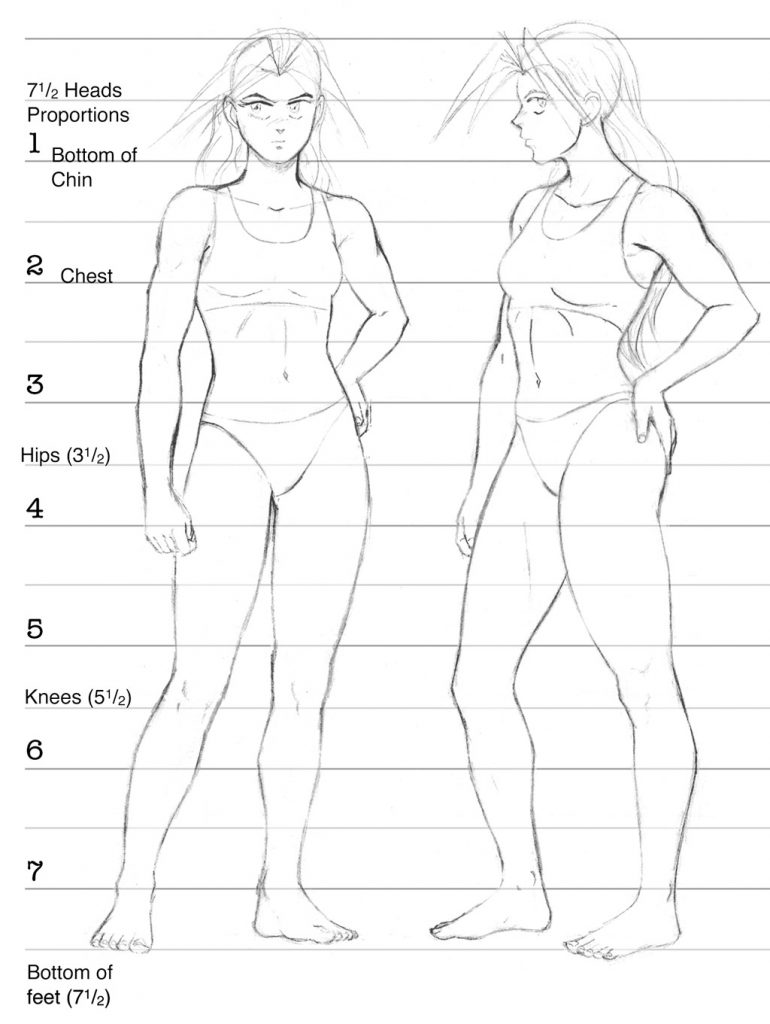
Kate is slightly shorter at seven 1/2 heads, which is closer to "realistic" human proportions. The one-half head is lost effectually the hips, making her trunk slightly shorter than Mike'due south, while her legs are about the aforementioned length equally his. The "heads" intermission downwardly as follows with her:
-
- Head
- Chin to breast
- Chest to height of the hips.
- Hips to widest bespeak of the thighs (bottom of the hips are about 3/4 of the way)
- Widest indicate of the thighs to above the knees
- In a higher place the knee to widest point of the calves
- Widest bespeak of the calves to top of the ankles
- Feet (1/2 caput)
Basically, Kate simply has a smaller upper body than her counterpart. Not only is it about a one-half head shorter, her ribcage is too narrower than her hips and that the midpoint of the shoulders sit roughly in line with the hips as well. Her joints are also narrower and her limbs thinner.
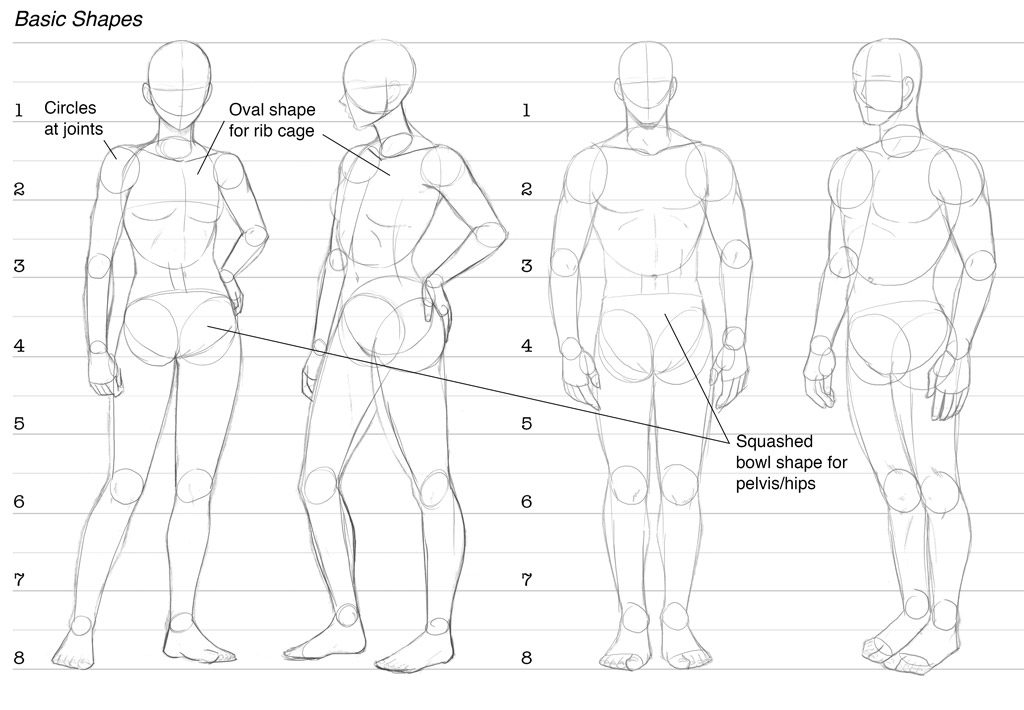
If we strip away the details and look at the underlying shapes, we can encounter how each figure is synthetic more hands. I use circles (which I remember of equally "balls") in identify of the joints and draw the forms of the limbs between those. I use an egg shape for the ribcage and sort of a flattened "basin" shape for the pelvis. I have developed simplified forms for each of the major body shapes: upper arms, lower artillery, thighs, calves & shins, hand and feet. (More on hands and feet in a moment). I also imagine the shoulder being fastened to the collarbone (which information technology is in reality, also at the scapula on the back) and so it is gratis to slide around up and down, back and along on the ribcage when I am posing the figure. Take note of the hip shapes betwixt the two figures.The male's pelvis is taller while the female's is shorter and a piddling wider. This has been a helpful observation for me in my effigy cartoon.
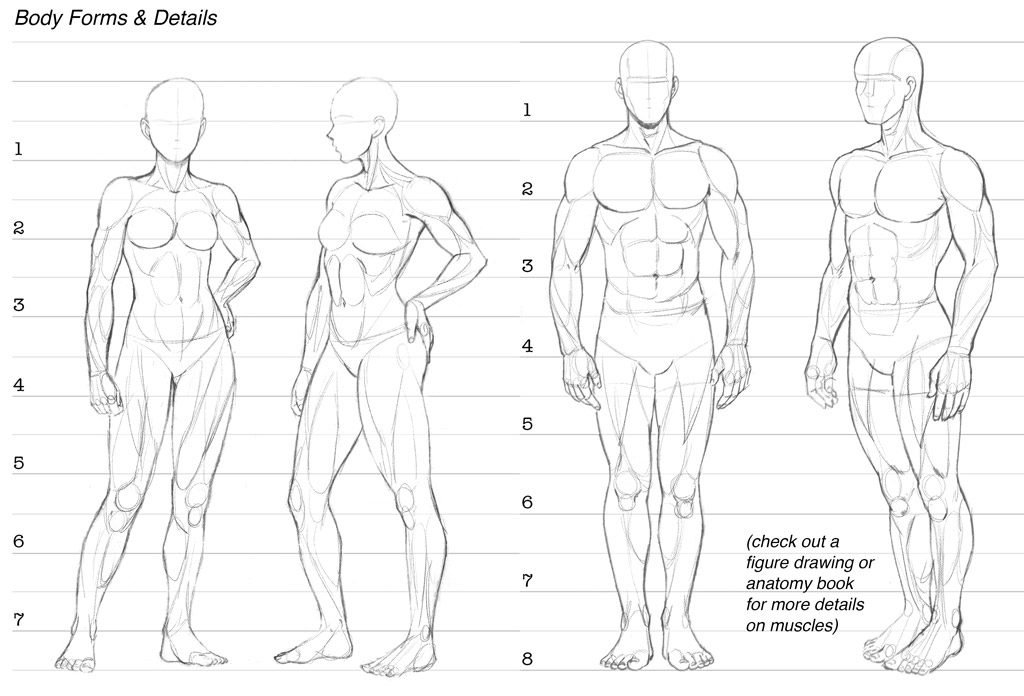
While I won't go into detail on muscular anatomy (there are entire books on that topic), here is a quick cheat sheet on the basic shapes I'one thousand thinking of when I'grand drawing the figure. These shapes are informed by countless hours of drawing characters and human forms from observation and copying drawings out of anatomy books. I highly recommend spending some fourth dimension on this yourself.
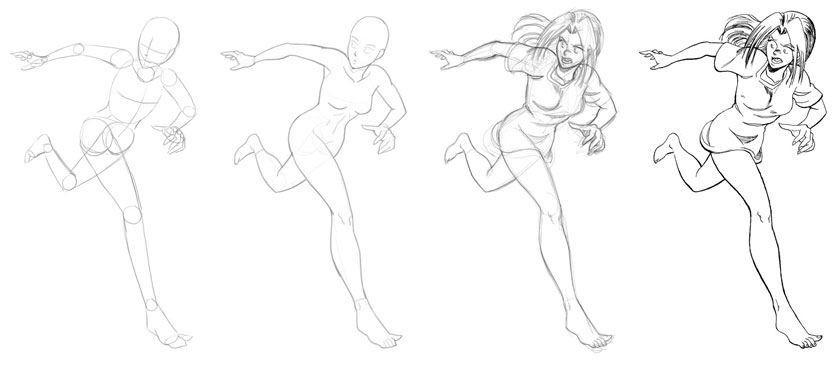
Strike a Pose
Okay, at present that we have the basic shapes and proportions down, nosotros demand to be able to draw our characters in more than close-ups and standing around doing nothing. Nosotros need to put them into motion so they accept on some life. To practise that, we demand to offset with a fluid set of lines, or "gestures". For the to a higher place drawing, I started with a rough cartoon like this:
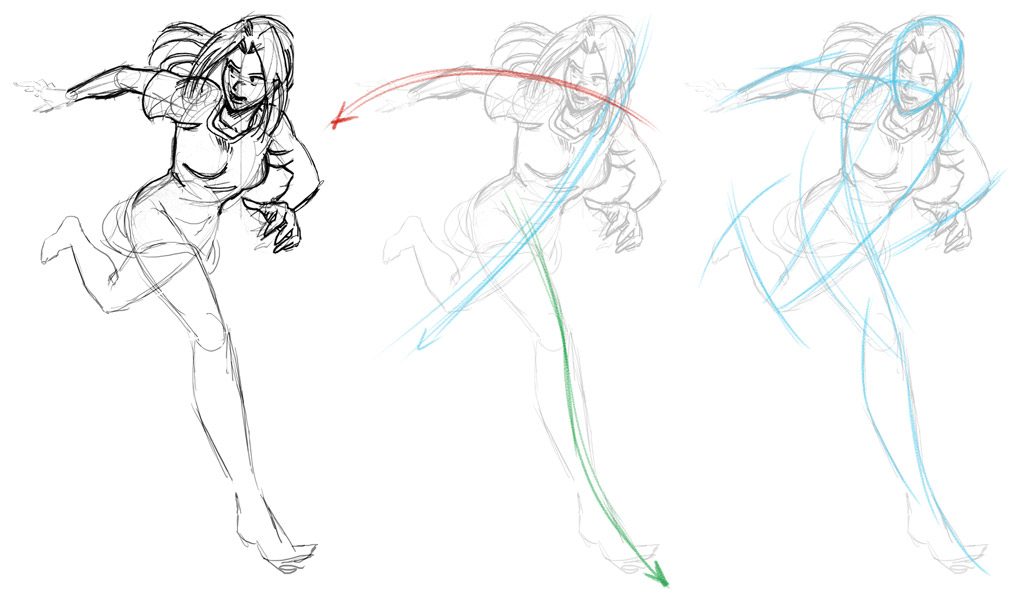 However, in the second image, these were the lines I was using to construct the figure. These are the "gesture" lines—named after 30-second "gestural drawings" which are often done at the first of a figure drawing course. The offset line in blue goes from Kate's head downwards to her knee. The second in blood-red arcs along her arms and shoulders, and the final, in green follows her outstretched leg. Notice how these curves aid tie the the forms of the figure together. I utilize lines like this to build up a pose so it has some underlying life. In the third image, here are some more "flow" lines that pass through the pose. These are the sorts of curves I wait for when edifice up a figure. No straight lines if I can manage it.
However, in the second image, these were the lines I was using to construct the figure. These are the "gesture" lines—named after 30-second "gestural drawings" which are often done at the first of a figure drawing course. The offset line in blue goes from Kate's head downwards to her knee. The second in blood-red arcs along her arms and shoulders, and the final, in green follows her outstretched leg. Notice how these curves aid tie the the forms of the figure together. I utilize lines like this to build up a pose so it has some underlying life. In the third image, here are some more "flow" lines that pass through the pose. These are the sorts of curves I wait for when edifice up a figure. No straight lines if I can manage it.
Hither are the rough forms I'thousand using to think through this rough effigy. I volition often draw a quick version like this equally a thumbnail, and and so draw these forms over the top of that rough to make clean up the anatomy.
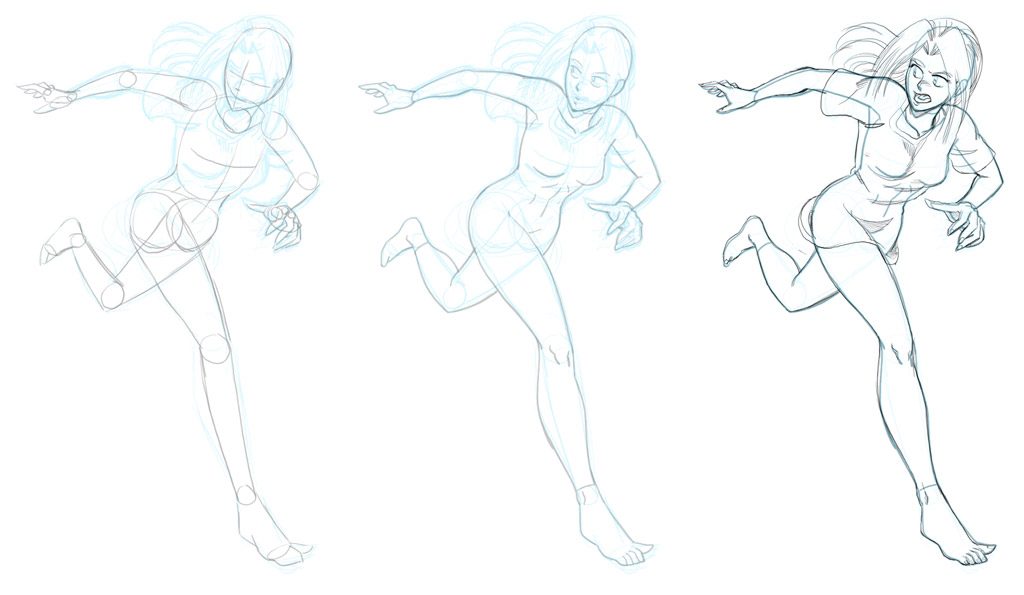
Once the anatomy and proportions are solid, I pencil over the rough and ink the concluding. I always use this process for creating my finished works. Past layering over more and more finished versions, the last benefits from having several chances to correct mistakes along the mode.
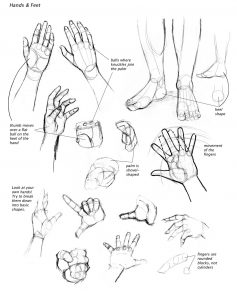
I could practice an entire post alone on drawing hands and anxiety (again, entire books have been written), but the brusque version is that the fashion to tackle these complex forms is the same every bit above: suspension them down into simpler shapes. I start with sort of a "shovel" shape for the palm, so draw a circumvolve to one side or the other on the wrist stop to announce the brawl of the pollex. Then I describe a smaller rounded shape on the other side to create the heel of the hand. Each of the four knuckles I draw as circles beyond the tiptop of the shovel shape, and then a fifth at the finish of the ball of the thumb. From there, I draw the fingers an thumb equally either a mass (if they are clumped together) or as curved lines roughly indicating each finger. And so I flesh out the individual joints of the each finger every bit separate shapes, keeping in listen that they are non cylindrical, but more similar like rounded blocks.
Drawing great hands takes a lot of practice, and the best way to go good at them is observation. Just like the residual of the figure, practice drawing from life and good reference photos to non only practise the forms of the hand, but besides to see how elegant hand poses come together. You volition start to see patterns in how the fingers move together every bit a loose group, not separately (which is why magicians are illustrated using weird hand poses—they don't await natural). I still practice by using my own hands equally reference to assistance create good hand poses.
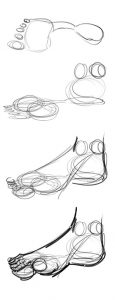 Feet are non as complicated as hands, merely they yet pose a challenge to people new to cartoon the effigy. Once more, breaking downwardly the forms into simpler shapes can be helpful.It'southward helpful to me to think of a footprint as a starting signal—the heel is separated from the ball of the foot and toes past the curvation of the foot. We can flesh out those shapes past using balls one time again: 1 larger 1 for the heel, and two smaller ones for the ball of foot, leaving room for the curvation on the inside curve of the foot. Higher up the heel is the talocrural joint, which has two pocket-size bones on each side that connect down to the peak of the brawl of the pes to create the main wedge of the foot. For the toes, I call up of the archetype "ninja sock" with the big toe acting independently of the rest of the toes, which generally dodder together as a group. When the character is wearing shoes, and then all the toes working together every bit a group. If you're cartoon a bare foot, and then go on in mind the smaller toes have a "stair-stride" shape to them.
Feet are non as complicated as hands, merely they yet pose a challenge to people new to cartoon the effigy. Once more, breaking downwardly the forms into simpler shapes can be helpful.It'southward helpful to me to think of a footprint as a starting signal—the heel is separated from the ball of the foot and toes past the curvation of the foot. We can flesh out those shapes past using balls one time again: 1 larger 1 for the heel, and two smaller ones for the ball of foot, leaving room for the curvation on the inside curve of the foot. Higher up the heel is the talocrural joint, which has two pocket-size bones on each side that connect down to the peak of the brawl of the pes to create the main wedge of the foot. For the toes, I call up of the archetype "ninja sock" with the big toe acting independently of the rest of the toes, which generally dodder together as a group. When the character is wearing shoes, and then all the toes working together every bit a group. If you're cartoon a bare foot, and then go on in mind the smaller toes have a "stair-stride" shape to them.
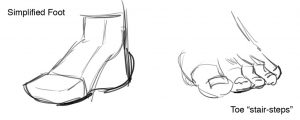
Once yous accept the bones human foot shape downward, you can piece of work on putting it in shoes or drawing it bare. It will accept some practise to primary these shapes, and then again, using references and live observation will help you refine your drawings.
Lastly, I desire to emphasize how helpful drawing in a sketchbook tin exist to help you refine your character drawing. For a couple of years, I drew character studies of Kate & Mike by using photos from magazines as a reference. I borrowed the poses and outfits, just transformed the models into my characters. The drawings below are from those sketchbooks.
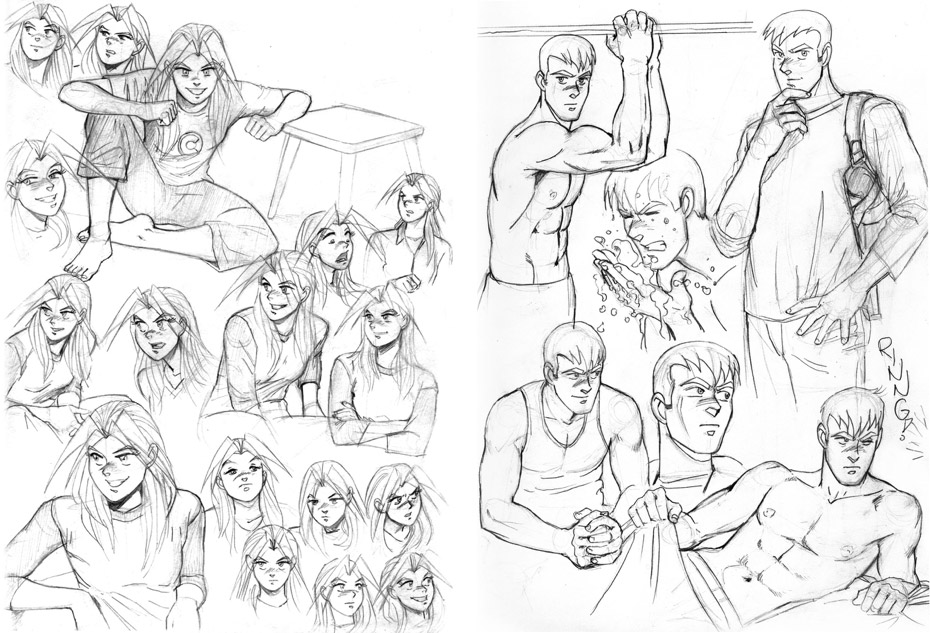
I hope this will assist you create your own character designs and give some tools to refine them.
Side by side time, we'll dive into the story.
If you're new to the serial, welcome! If you'd like prompt updates most the next installment of the series, exclusive cheat sheets, and other backside-the-scenes fabric with each installment of the serial, delight sign up for my mailing list:
Source: https://www.dirktiede.com/2017/11/03/how-to-draw-comics-character-design-drawing-the-figure/
0 Response to "Quickly Draw Body for Comics"
Postar um comentário